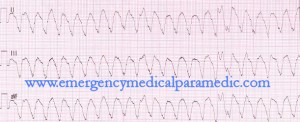Ventricular Tachycardia
Ventricular Tachycardia (VT) is a lethal arrhythmia that will result in death if left untreated. As paramedics, this is where you get to do something to save a person’s life! In ventricular tachycardia, the ventricles are firing from multiple foci, resulting a fast, ventricular driven heart rate.
Ventricular Tachycardia ECG
Heart Rate: between 100 and 300 beats per minute. The faster the rate the less sustainable the rhythm is.
Rhythm: usually regular.
Pacemaker Site: ectopic ventricular pacemaker.
P Waves: may be present or absent.
QRS Complexes: usually wider (greater than .12 seconds) and bizarre.
Ventricular Tachycardia Signs and Symptoms
Any person in VT is unlikely to be conscious. They will show signs of profoundly poor perfusion, including absent palpable pulses. In certain circumstances people have conscious VT in which they remain conscious throughout being in VT. These people, given the ability to talk, would most likely feel symptoms, of confusion, dizziness, extreme weakness and a sense of impending doom.

